How To Make Spicy Strawberry Jam Without Pectin
Homemade Goodies: Spicy Strawberry Jam
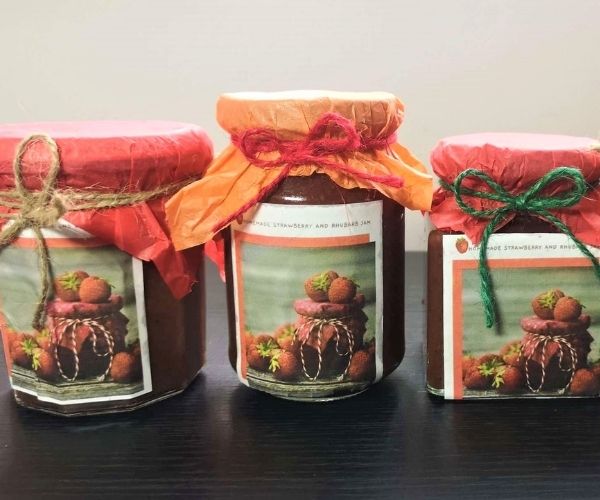
Spicy strawberry jam is the main type of preserve I make in the summer with freshly picked fruits from my allotment. Usually, the combinations include strawberry and rhubarb – a tad tangy, raspberries, currants or any other berry that goes well with strawberries.
This post may contain affiliate links, which means I will receive a commission if you purchase through my links, at no extra cost to you. Please read the full disclosure for more information. Thank you!
The idea is to make my jam at home because it is easy, cheap and healthy. In addition, the jam is organic, and the only things I add to it apart from organic coconut sugar are spices.
Every time I pick strawberries and make the traditional and mandatory at our house chocolate-dipped dessert, there are enough fruits left to make a few jars of jam. If I have any other fruit available, I try combinations.

While the fruits cook at low heat, I test spices blends. As a result, not two of my jams are the same, and each has a different flavour.
I will explain here the basic process and how to make spicy strawberry jam without using pectin. When you try yours, remember that any berry combination is alright. Also, keep in mind that jam should be more fruit than sugar, using the fresh, organic product, and this is the difference from mass commercialised one: you are making a healthier food at home.
What is pectin, and do I really need to use it when I make jam?

Pectin is a type of fibre naturally found in plants. Humans do not digest pectin unless it is modified for this purpose. “Modified” puts me off just at the sound of it, no matter how “healthy” it still seems at the end of the process.
I know one thing: for thousands of years, humans have consumed what nature had to offer. Come the industrial revolution and population explosion, everything needs to be “modified”, “enhanced”, and generally “processed”.
I get the need to make more food to feed more of us, make it last longer (have you wondered what the lists of Es are on food labels?) and the use of chemicals to make it look more colourful, smell better or last forever. But really, what is left of the natural product after so much “processing”? What do we really eat? How does it affect our body?
“More”, “perfectly shaped”, or “longer lasting” does not necessarily mean healthy.
At least you know what ingredients you used, their source, and their natural qualities in homemade foods.
If the next AI-enhanced generation of humans will survive on plastic, so be it. But, for the time being, I adore eating a fresh, organic, juicy strawberry as I pick it from my plot or make whatever I decide to make at home using as little industrial intervention as possible.

Modified pectin – digestible by our bodies – can be used to thicken jams. But jam thickens naturally if you boil it longer! Because the fruits have enough pectin in them to do just that! And as I learned in school aeons ago, liquids evaporate at high temperatures over some time; thickening occurs naturally.
So just a simple physical process of boiling does the same thing as adding modified items to your foods just for the sake of making it faster. If you think it pays to earn time over your health, I know otherwise!
The bottom line is, if you don’t mind a softer, easier to spread jam as opposed to the very thick one you can actually cut with a knife and never spread properly, then you do not need to add pectin to jams.
Sugar/fruit balance in jams

This is a subject I can spend hours debating!
We all eat jam. Our moms made it when we were kids. Of course, as the times changed, jam too turned into comfort food, mass-produced and readily available item in any grocery shop. But some of us still see the fun in making it at home.
I have tested jams made by my grandmother, mother, friend’s mothers, friends. I read countless recipes in six different languages just out of curiosity.
There is no perfect recipe for jam. It is more a matter of taste.
What I found funny, though, is how some prefer it incredibly sweet and decided that refined sugar gives jam the taste.

I read bonkers recipes in which people used 3 kg of refined white sugar for each kg of fruit. How insane is that?
The main ingredient in a jam is fruit, not sugar! And it is still pectin found in fruits that thickens jam, not sugar!
Another funny thing I heard was that sugar acts like a preservative. I am still trying to figure out how.
Salt is a disinfectant, so it prevents bacteria from developing in conserved foods. How on earth would sugar do the same thing? Taste enhancer – I get that. It makes sense. But preservative? Really?
Of course, if you Google it, it will tell you how wonderful it is in very attractive terms. But use your brain, and don’t take for granted any information that serves a purpose.
Any fruit has a natural sweetness, even rhubarb (although it is a vegetable, not a fruit, but makes good jam)! It is called “naturally occurring sugar,” and it counts as calories.
So if you make fruit jam, better make it from fruit! The last time I checked, refined sugar was no fruit.
The type of sugar I settled for years ago after trying many options is organic coconut sugar. I chose it because it is less processed, it has a lower glycaemic index and because I don’t care if my foods have a brownish colour! Perfect foods are like perfect people in magazines: altered!
Likewise, everything I bake is low in sugar. This is because the taste of foods comes from spices; add a ton of sugar or six teaspoons – the difference is still in the spices!
In general, for each kg of fruit, 200 g coconut sugar is quite enough for sweetness in jams. However, it is alright to add an extra tablespoon or two of sugar to the sourer fruits.
Why spicy strawberry jam?

If you like spicy chocolate, you will definitely like spicy strawberry jam too! Jalapeño chocolate? Yes, please! Because no rule said that sweet and hot don’t go together.
A dash of ground pepper thrown in your jam will make it just a little hot and intense – a daring variation to a classic recipe.
Cloves and cinnamon are classic spices that work in some types of jam. However, I prefer them for autumn fruits such as plums.

The zest of lemons or oranges also enhances the taste of jams. The key is moderation – too much zest can result in a bitter taste.
Vanilla and rum would also bring flavour to jam.
Again, because it is more a matter of personal preferences, it is best to try various combinations in small recipients. Then, if you are pleased with the result, use your chosen spice for the entire quantity.
My secret ingredient for jams

It will not be a secret after this, but there is a plant whose leaf gives the jam a specific aroma. I am talking about rose-scented geraniums, or Pelargonium graveolens, as they go by their scientific name.
Mom always used it, and perhaps this is why I still like it and continue to use it in jams. The trick is to dip a couple of leaves in the pan towards the end of the cooking process and only for a couple of minutes. Any longer than that, the aroma will become prevalent and cover that of the fruits. And we are still talking about how to make fruit jam!
I grow a rose-scented geranium in a large pot in my garden. I brought cuttings from Romania a few years ago, and they adapted very well to the UK climate.

This large pot has a strong fragrance and blossoms into a beautiful purple mid-summer to late autumn. I placed it strategically on the patio to enjoy the scent any time we are out in the garden.
What is peculiar about this plant is that the leaves are fragranced, not necessarily the flowers. Hence, their use in baking, drink and jam making.
How to sterilise the jars for jam
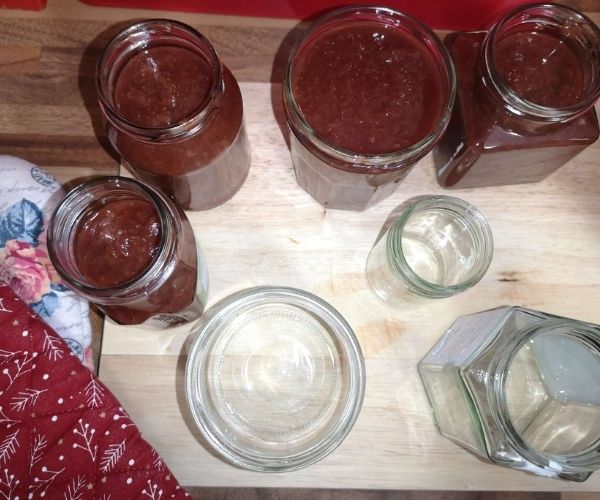
My method of sterilising the jars is simple: firstly, I wash the glass jars and lids with hot water and dishwasher, rinse well and dry.
I keep the lids aside, face-up on a towel, careful not to stick my fingers in them after washing.
The glass jars go into the microwave for two sessions of two minutes each, at medium intensity.
I always do this step after turning the heat off and leaving the jam pan aside for a few minutes.
Microwave sterilisation worked for me and preserved the jam for at least a year. I remember that mom used to sterilise the jars by boiling them and the content for hours in gigantic pans. Unfortunately, I do not have enough time for that nor space for huge pans. Hence this method I’ve used for years and proved helpful.
Hot jars have to be handled carefully and wearing protective oven gloves.
It is important that the jar heat is similar to that of the jam; otherwise, the jars can crack. This happened to me only once in donkey years because I rushed to fill the jars and skipped the second session of microwaving them.
The jam was hotter than the jars, and the first one cracked. I saw it coming but still did not prevent it from happening. Lesson learnt!
Another important thing that helps jam last better and longer is ensuring that the lids are hermetically sealed. I do this by turning the filled jars upside-down once the jam had slightly cooled. I never do this with hot jam as the lids have a plastic lining. As we know, plastic at high temperatures releases all sorts of chemicals harmful to humans, especially BPA.
If you look carefully at a jar lid, a circle in the middle goes down as you press with a finger and returns to the initial position when you release the pressure.
When you turn the jar upside-down and leave it until the jam cools entirely and then bring it to a normal standing position, a suction happens as an effect of cooling the previously heated metallic lid. This keeps the middle circle of the lid sucked down and, to me, is an indicator that the jar has sealed hermetically.
This is a non-scientific explanation of a physical process. Of course, any scientist can confirm/refute the veracity of it. But I speak from practical experience, and I know it works!
Labelling jam jars

Labelling is an optional step. However, I still do it because I am a perfectionist! Since I discovered Canva (a free version is available), I design my labels and print them on sticky gloss paper (if I have enough patience to calculate and convert pixels to cm to get the right printing size). A more straightforward method is to print labels on regular paper and glue them to the jars after they cooled.
On the label, I write the type of jam/fruits used/spices and the date I made it.
By October, various jars of different colours line up orderly on the upper shelf of the fridge, waiting patiently to be used over the winter.
How to store jam

Mom used to store the jam in a cold and dark pantry. Besides, the winters in Romania used to be bitterly cold; she even kept cooked foods in the pantry and saved electricity.
My modern house has a fridge that serves the purpose. Jam is, in essence, preserved fruit that we use when fresh ones are not available.
Made as explained here and stored as detailed above, my jam lasts for over a year on the upper shelf of the fridge, at around 6-8°C.
What is the best use for jam?
Spread on buttered bread (optionally).
Baking is another good use for jams.
Jam can also be used to make fruity yoghurt, sorbet or ice cream.
Some people use it in cooking, especially as a sauce for meats. However, I prefer not to mix fruits and meats since I read that the fermentation process can lead to cirrhosis.
To this day, the best use of jam is in crêpes; I have enjoyed it as a child and still do.
Ingredients for spicy strawberry jam
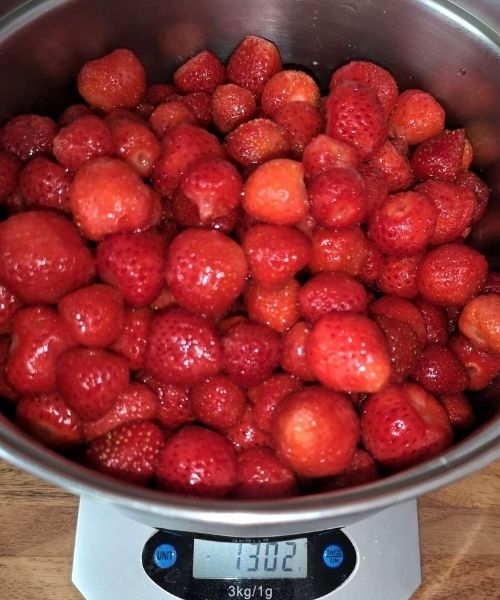
Strawberries (optionally, you can combine with any other berries, rhubarb etc)
Coconut sugar
Ground pepper
Ground cloves
Rose-scented geranium leaves
Method

Wash and hull the strawberries; place them in a double bottom stainless steel pan over low heat. If required, mash the fruits slightly (most of them will mash naturally during the process).
Do not rush boiling and keep the heat to a minimum throughout making the jam; a higher flame might burn the fruit at the bottom of the pan.
The purpose of using a double bottom pan is to prevent the fruits from burning and sticking to the pan. Occasional stirring with a wooden/stainless steel spoon will also help.
After adding sugar, the stirring has to be more frequent, as the sweetened fruit’s tendency to stick to the pan will increase.
The strawberries should cook for at least an hour and a half to thicken enough.
Towards the end of cooking, add the spices and geranium leaves. Turn the heat off, remove the pan from the hob and allow the jam to cool slightly.

Meanwhile, sterilise the jars as explained above. Then, place the jars on a wooden chopping board and have the lids available at hand.
Both the jars and the jam should be at a similar temperature. Apply extra caution during this step to avoid burning. Preferably, ensure there are no children or pets in your working area.
Use a large stainless steel spoon to transfer the jam from the pan to the jar, spoon by spoon. Pay attention to any cracking noise. If this happens accidentally, stop filling the respective jar and dispose of it safely.
I recommend filling the jars almost to the brim, with only about 1 cm/half an inch left free at the top.
When all the jars are filled, screw the lids tightly and allow further cooling.

Before the jars cool entirely and are still warm to touch, turn them upside-down and leave overnight or for a minimum of a couple of hours until completely cooled.
Perform the lid circle test as explained above. If the metallic centre of the lid remains in a concave position (curves inwards), it means that the jar is hermetically sealed and will preserve the jam for at least a few months.
Preferably, store the spicy strawberry jam in the fridge, on the upper shelf where the temperature is slightly higher than in the fruit box.
Check each jar regularly. If at any point you discover a mould pellicle forming at the top, discard the jar immediately as it means the jam is contaminated and not safe for consumption.



Spicy Strawberry Jam
Equipment
- Double bottom stainless steel pan
- 4 glass jars with lids
- large mixing spoon
Ingredients
- 1 kg strawberries organic
- 200 g coconut sugar organic
- 1 tsp black ground pepper flat
- 1 tsp ground cloves flat
- 2 pcs rose-scented geranium leaves freshly cut, washed
Instructions
- Wash and hull the strawberries.
- Place the fruits in a double bottom stainless steel pan over low heat.

- Mash the fruits slightly (most of them will mash naturally during the process).
- When the fruit reduced, add the coconut sugar and stir frequently.
- Towards the end of cooking, add the spices and geranium leaves.
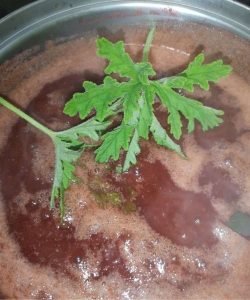
- Turn the heat off, remove the pan from the hob and allow the jam to cool slightly.
- Sterilise the jars in the microwave as explained above and place them on a wooden chopping board. Have the lids available at hand.
- Use a large stainless steel spoon to transfer the jam from the pan to the jar. Pay attention to any cracking noise. If this happens accidentally, stop filling the respective jar and dispose of it safely.

- Screw the lids tightly and allow further cooling.
- Before the jars cool entirely but are still warm to touch, turn them upside-down and leave overnight or for at least a couple of hours until completely cooled.
- Perform the lid circle test as explained above. If the metallic centre of the lid curves inwards, it means that the jar is hermetically sealed and will preserve the jam for at least a few months.

- Preferably, store in the fridge, on the upper shelf.


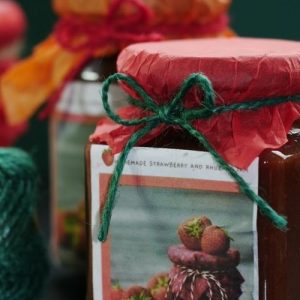


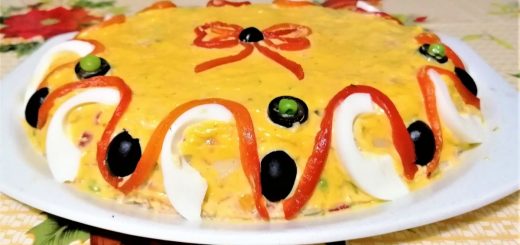














This recipe is awesome! The jam turns out to be SO tasty! I also looove that it uses coconut sugar. Thanks so much for sharing.
I love a spicy sweet condiment! This recipe is amazing…I don’t have high hopes for this year’s strawberry harvest, but if I can get my hands on some berries this is exactly what I will do with them!
This is a great recipe, we love all things spicy here, I usually add a slice of lemon or the seeds for pectin…but I am going to try this
Wow this is such an interesting jam recipe! I have never heard of that method with your special ingredient! I love it
I love a good jam! This spicy strawberry jam was so delightful! Such a nice take on regular sweet jams!
I’ve always wanted to learn how to make my own jam without pectin. Thank you for this delicious and simple recipe! It turned out great and we made a huuuge batch!
What an interesting jam recipe. I love the added pepper inside. I must make this asap. I love the sound of this.
I have never heard of spicy strawberry jam before. Nice idea, an I especially like the rose-scented geranium thought. Thanks for sharing!
This looks really yummy!
Wait till you taste it!:))
Thank you so much for sharing your secret! I tried it and it turned out so good!
I am so glad to hear it!:)
I love this jam, and those LABELS! Thank you!
Aww, thanks, you’re too nice:)
Ever since I moved to Canada, I have don’t get the annual supply of strawberry jam from my grandma. This recipe is awesome and I we finally have homemade strawberry jam back in the house.
These are perfectly spiced and so darn yummy!
Great and easy to follow recipe, exactly what I was looking for!
This jam looks amazing. I also like to add less sugar whenever possible. Now I need to find a rose scented geranium!
I was looking for a recipe to try making jam for the first time and yours sounds great!
Sounds delicious. I love strawberry preserves but I have to say plain strawberry jam is sometimes too bland. Adding some spin will will make it great. Love your labels too!
This sounds so yummy. I so appreciate you sharing about pectin and how you make it completely natural. Wonderful post. 😊
Pastor Natalie
Letstakeamoment.com
For real, I tried a traditional jam recipe once and it really turned me off of jam seeing all that sugar go in. This recipe looks amazing! Will have to try
I haven’t had jam in years. I love Jam. It taste so good. I would totally love to try out this recipe.
This sounds so unique and amazing. I love the combination of sweet and spicy!
Okay, spicy strawberry jam sounds devine! I will totally have to try making this sometime.
Thank you for the thorough instructions on how to make jam. My jam turned out perfectly.
I love strawberry gam! I’ve got to try it out.
This was absolutely delicious, thanks for the recipe!
This is such a perfect idea for my fresh strawberries!! Thank you so much for the recipe!
It turned out very well for me. Thanks for sharing!
This was delicious! I just love the spice that the cloves added with the sweet strawberries.
Perfect use for all my strawberries! I love the spice!
Love this post. I love the recipe too… I’ve used lemon geranium leaves in bases of cakes but I’d never thought of using the rose-scented ones in strawberry jam. It’s really interesting how you store the jam too. This is the part of jam making that I always have problems with, getting that seal so that they last a while. As soon as my strawberries ripen I’m going to be making jam. 🙂
I love this! I would have never thought to make a spicy strawberry jam! So good!
Easy and delicious!
This looks so good! I love the idea of mixing spicy and sweet together. Will be trying this soon!
This sounds like such a fun variation on regular strawberry jam. Need to try it!
Love the recipe I will do this
Homemade jam makes such a fantastic edible gift – this sounds delicious!
This is making my mouth water, YUM!
I loved making this jam! It was so easy and it came out amazing! It was my first time putting a little spicy kick in it haha. I love how healthy it is compared to all the store bought brands.
I love to make homemade jam. It is satisfying to make something for your family to enjoy all year long. The spicy strawberry jam sounds amazing. My family loves a little kick to their foods and this jam seems like a great way to start your mornings.
I think the spice combination is just great! I have to try this as soon as possible! Thanks for the great idea!
I was a little nervous to make jam on my own but your instructions are giving me lots of confidence!
I made a few jars of strawberry jam this week as well. I tried reducing the sugar in the recipe and let it cook longer to thicken up. I also want to experiment making jam with monk fruit sweetner, for something more natural and low calorie. The addition of spicy to your jam sounds amazing. I always add vanilla and lemon zest to mine, to give it an extra pop of flavour.
Me too; lemon or orange zest is my favourite extra and most used in jams. I’ll check this sweetener you speak of; thanks for the idea:)
This spicy jam sounds amazing!! I have an abundance of strawberries begging to be canned so I am going to give this a go.
Let me know how it goes:) I’ll make another batch this evening; somehow I ended up with another basketful of strawberries:))))